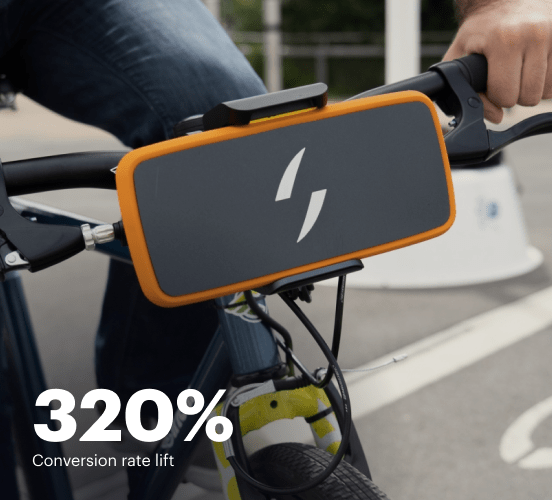Jimdo vs. Canva: the best platform for a seamless web experience
Discover how Jimdo compares to Canva regarding features and usability. Find out which platform provides the competitive advantage your business deserves.
Get startedSee how Instapage stacks up against the competition
| Feature | Instapage | Other builders |
| Drag-and-Drop Tools | ||
| Conversion-optimized templates | ||
| Manual and AI-powered A/B Tests | ||
| AI content suggestions | ||
| Popups and sticky bars | ||
| Canvas and grid blocks | ||
| Reusable and global elements | ||
| Form and popup builders | ||
| Built-in Heatmaps | ||
| Central analytics dashboard | ||
| Ad-to-page personalization and collections | ||
| Contacts, lists, and email | ||
| Dedicated, full-service CRO experts | ||
| Enterprise-ready platform |
Leading the way in building high-performing landing pages





Why Instapage is the smarter choice for your campaigns
Get everything you need to build, scale, and optimize high-converting landing pages—without coding.

Easier page building without coding
Instapage offers a flexible and seamless page creation experience with a library of 500+ conversion-focused layouts, Instablocks®, a drag-and-drop builder, and AI content generation. With technologies like Thor Render Engine®, you can create on-brand, mobile-responsive landing pages that load quickly and start converting during initial visitor clicks.

More insights — better results
Instapage lets you see in detail how each landing page experience and variation is performing so you can make targeted changes that boost page conversions. Use heatmaps for a better understanding of on-page activities, run A/B tests and AI-assisted experiments, and then track and evaluate results within robust analytics dashboards.

More personalized experiences
Instapage lets you quickly create high-performing landing pages tailored to each of your ad campaigns. Deliver personalized experiences for distinct audiences using dynamic text replacement. Effortlessly align specific advertisements to unique pages with AdMaps. Monitor audience-level metrics using our advanced data tools.

Built-in collaboration
Instapage collaboration capabilities bring your entire team together to speed up the process of landing page review, approval, and launch. No more frustrating and unnecessary revisions or edits scattered across emails. Provide instant feedback, conduct real-time page edits, and securely share your pages with outside stakeholders.

Free up time for your business
Invest time into business growth, not busy work. Launch landing pages faster with reusable forms and templates. Build once, reuse forever.
Explore all integrations






Easier page building without coding
Instapage offers a flexible and seamless page creation experience with a library of 500+ conversion-focused layouts, Instablocks®, a drag-and-drop builder, and AI content generation. With technologies like Thor Render Engine®, you can create on-brand, mobile-responsive landing pages that load quickly and start converting during initial visitor clicks.
More insights — better results
Instapage lets you see in detail how each landing page experience and variation is performing so you can make targeted changes that boost page conversions. Use heatmaps for a better understanding of on-page activities, run A/B tests and AI-assisted experiments, and then track and evaluate results within robust analytics dashboards.
More personalized experiences
Instapage lets you quickly create high-performing landing pages tailored to each of your ad campaigns. Deliver personalized experiences for distinct audiences using dynamic text replacement. Effortlessly align specific advertisements to unique pages with AdMaps. Monitor audience-level metrics using our advanced data tools.
Built-in collaboration
Instapage collaboration capabilities bring your entire team together to speed up the process of landing page review, approval, and launch. No more frustrating and unnecessary revisions or edits scattered across emails. Provide instant feedback, conduct real-time page edits, and securely share your pages with outside stakeholders.
Free up time for your business
Invest time into business growth, not busy work. Launch landing pages faster with reusable forms and templates. Build once, reuse forever.
Explore all integrationsGet started with Instapage in a few steps
-
Create your Instapage account
Start with Instapage by signing up via Google or your email. You'll get access to a free 14-day trial to discover Instapage capabilities. Feel free to cancel anytime during the 14-day trial if you decide that our product is not suitable for your business. -
Build and personalize your page
Create your first landing page from scratch or choose a template from 500+ customizable layouts. Use the drag-and-drop builder to add page elements, fonts, and backgrounds, refine content with AI, or add custom HTML, Javascript, and CSS. -
Review and make edits
Collaborate on page designs and streamline review processes. Invite your team members and stakeholders to review, edit, and provide feedback on your landing page. Collaborate knowing your page is confidential and only accessible to authorized users. -
Publish and track page performance
Publish your page to a domain or custom URL. Connect your pages to the ads you've created and track page performance within the analytics dashboard, run A/B tests and AI experiments, analyze results, and continuously optimize your landing page to maintain high conversions.
Jimdo vs. Canva: A Competitive Clash with an Intriguing Twist
In the bustling realm of digital marketing, selecting the right platform can feel like trying to choose the best rollercoaster at an amusement park. With so many options available, it can be challenging to find the perfect fit for your website and design needs. Enter Jimdo and Canva — two juggernauts that have made their mark in the industry. Both platforms offer unique strengths that cater to different types of users from small businesses to creative individuals. Jimdo is known for its website-building prowess, providing easy-to-use tools for creating a professional online presence. On the other hand, Canva shines as a design tool, enabling users to create stunning visuals effortlessly. As we step into the ring to compare these contenders, let's not forget Instapage, a powerhouse lurking in the shadows, ready to take on the best of both worlds. Will Jimdo and Canva prove their dominance, or will Instapage make a compelling case for supremacy? Buckle up as we navigate the features, usability, and pricing of these platforms, exploring what they offer and how they stack up against one another in this intriguing showdown.
Introducing the Contenders
As we look into the landscape of digital marketing tools, both Jimdo and Canva stand tall. Jimdo is designed primarily for building websites, providing users with a user-friendly interface that's perfect for those new to online marketing. Its drag-and-drop functionality makes it easy to create pages without needing extensive technical knowledge. The platform offers integrated eCommerce capabilities, making it an attractive choice for businesses looking to sell online. Canva, by contrast, is the go-to platform for graphic design. Known for its simple yet powerful tools, Canva allows users to create everything from social media posts to marketing materials with remarkable ease. With a vast library of templates and design elements at your fingertips, it's a designer’s dream. Yet, amid these two strong players, Instapage shines as a dedicated landing page platform, offering features that enhance conversion rates unlike any of its competitors. As we delve deeper into the features, usability, and pricing of these platforms, we’ll discover what sets each apart and what they share in common.
Feature Showdown: Jimdo vs. Canva
In terms of features, both Jimdo and Canva bring their unique strengths to the table. Jimdo specializes in providing users with a robust website builder that includes customizable templates, responsive design, and integrated SEO tools. It offers a variety of eCommerce functionalities, allowing users to manage products, track orders, and accept payments seamlessly. Canva, on the flip side, offers an extensive collection of design tools including customizable templates for virtually any type of visual project. Users can access a plethora of images, graphics, and fonts, making it easier to maintain a consistent brand identity across all marketing materials. While Jimdo’s feature set is heavily focused on web creation and management, Canva aims to empower users in the realm of graphic design. However, let’s not forget that lurking in the wings is Instapage with its robust analytics and optimization tools designed to enhance the effectiveness of landing pages. It often takes the spotlight for its unique offerings in the area of conversion optimization.
User Experience: A Friendly Face-Off
When it comes to usability, Jimdo and Canva cater to different user bases. Jimdo focuses on individuals and businesses looking to create websites without any prior coding knowledge. Its guided setup makes it easy for first-time users to choose a template, customize their content, and launch their online presence quickly. In contrast, Canva’s user-friendly design tools cater to creative individuals, from social media managers to small business owners looking to create eye-catching visuals. The platform is designed to let users express their creativity without feeling overwhelmed. One might say the learning curve resembles a rollercoaster ride: thrilling for some and a bit daunting for others. Both platforms ensure that their users, whether they’re novices or experienced, have the resources they need to succeed. While Jimdo provides tutorials and customer support for website creation, Canva’s extensive library of design tutorials and community resources ensures users can learn and improve their design skills easily.
Jimdo's Key Features to Note
- Intuitive website builder with drag-and-drop functionality
- Customized SEO tools for better search visibility
- Integrated eCommerce features for selling products online
- Responsive designs that adapt to any device
- Analytics tools for tracking website performance
Highlighting Canva's Standout Features
- Vast library of templates for various design needs
- Easy-to-use interface tailored for both beginners and pros
- Extensive collection of stock photos, illustrations, and fonts
- Collaborative design options for team projects
Common Strengths Shared by Both Platforms
- User-friendly interfaces that cater to beginners
- Support and resources for enhancing skills
- Integration capabilities with third-party tools
- Mobile-responsive designs for accessibility
- Regular updates and improvements based on user feedback
- Versatility in serving various business needs
As we navigate through these features, it's clear that both Jimdo and Canva have their unique strengths in the digital landscape. However, as we continue to explore and analyze their offerings, one can't help but notice Instapage as a formidable contender that stands out for its focus on conversion optimization. Instapage specifically equips businesses with tools that maximize landing page performance, making it an appealing option for those focused heavily on online marketing and sales conversions. It becomes evident that while Jimdo and Canva are solid players in the game, Instapage might just have the competitive edge that businesses seek in today's fast-paced marketing environment.
Performance Metrics: The Speed Test
In the world of web design and performance, loading speed and mobile responsiveness are crucial elements dictating user experience. Jimdo's website pages are designed to load quickly, minimizing the potential for visitors to bounce away in frustration. The platform prioritizes performance and is optimized for speed across various devices, ensuring that users can access web pages effortlessly. Canva, while primarily focused on design, also values performance in its platform. Users can create stunning visuals without the lag that often accompanies heavy graphical applications. However, if a user tries to upload excessively large files, they may encounter delays reminiscent of molasses in winter. It’s critical to keep file sizes manageable when using Canva to maintain performance. Ultimately, both platforms recognize the importance of speed in today’s fast-paced digital environment. Yet it’s Instapage that truly excels here, streamlining pages and ensuring that they are fully optimized for fast loading times, which is essential for maximizing conversions.
Support Channels: Choosing Your Sidekick
When it comes to support, both Jimdo and Canva provide commendable options for users navigating their platforms. Jimdo offers various support channels, including detailed documentation, customer service via email, and an extensive knowledge base that addresses common user queries. They aim to empower users with the information they need to succeed at every step of the website-building process. Canva, on its end, boasts a vibrant community that fosters creativity and collaboration, along with an extensive help center filled with tutorials and design tips. Users can also access support via email, helping those who may run into bumps along their design journey. Both platforms pride themselves on having robust support channels, yet Instapage's dedicated customer support is tailored specifically to marketers, offering them the resources and guidance to optimize their landing pages effectively.
Pricing Wars: Who Wins?
Analyzing Jimdo's Pricing Strategy
- Affordable tier suitable for startups and freelancers
- Ecommerce functionality included in higher-tier plans
- Free plan available with basic features
- Ease of upgrading as business needs evolve
Exploring Canva's Flexible Pricing Structure
- Free tier offers access to a wide range of design features
- Subscription plans available for greater functionality
- Discounts offered for non-profits and educational institutions
- Pay-per-use options for premium assets available
To wrap up our pricing strategies comparison, Jimdo’s unique structure appeals to startups with its affordable tier, while Canva’s flexible pricing provides value across various use cases. Instapage offers a competitive edge with its pricing strategy—specifically catering to businesses focused on maximizing revenues through optimized landing pages. Their price points reflect the platform's immense value for businesses keen on boosting conversion rates without breaking the bank.
Looking into pricing plans for both platforms, it becomes evident that users can find options that fit both their needs and budgets—while enjoying a range of features. However, it’s crucial to note that with any pricing strategy, users often discover hidden gems of value that can enhance their business results, allowing for surprises that may come from unexpected places.
The Shadow of Instapage: A Closer Look
Finally, as we reflect on our exploration of Jimdo and Canva, it's essential to shine a light on Instapage. This platform acts as a mentor with its landing page optimization features, working tirelessly behind the scenes to elevate conversion rates. What sets Instapage apart is its focus on dedicated landing page strategies, providing users with features that specifically address the challenges of optimizing for conversions and enhancing user experience. Users find unique offerings like A/B testing, heat maps, and personalized experiences that aren’t readily available with either Jimdo or Canva. As such, Instapage could easily become the secret weapon that businesses weren't aware they needed, helping them navigate through the complex landscape of digital marketing with confidence.
In closing, when it comes to digital marketing platforms, making informed decisions based on your unique needs can drive success. As you assess Jimdo, Canva, and Instapage, think about your personal goals, whether it's crafting stunning visuals, building a website, or enhancing conversions on landing pages. Each option has something to offer, but perhaps Instapage may just provide the ultimate solution that propels your marketing journey to new heights.










